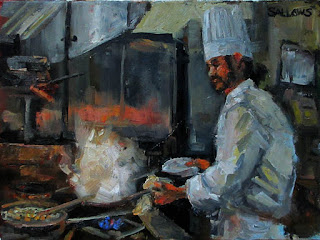If you're like me you have a lot of paintings hanging around that are just, for lack of better words, "no good". You can't sell them. You've tried. You don't want them hanging on your wall. You live in the city and bonfires are illegal. So you recycle the canvas. That doesn't mean you throw it into the trash. No- you sand it lightly (outside) to get rid of the gloss, rub a bit of OMS onto it, then turn it upside down and begin a new painting. The cracks and ridges become part of the new piece and may or may not add some textural interest. It's always a gamble but it's also fun to get out the palette knife and play with your paint. There is less concern about maintaining the integrity of your design--WHAT DESIGN??? And you have a lot of freedom because you're not tied into a tight concept. I like to use one or two photos as "the concept". Here the concept was sous chef and the red brick wall in the original painting becomes the backdrop for the hot cooktop.
One advantage to creating a painting over another painting, and there are many, is that the darks are richer and deeper immediately. Layering oil paint creates interesting color and when you layer cools over warms and vice versa (at random) you can create colors that surprise and delight the viewer. The tactic would not work at all on a "fresh" painting. It's a technique that works best on an uneven and colored ground. And that's exactly what an existing painting is.
Here is the original painting- upside down-- and the final version of "Chef Jeff, the Sous Chef"



No comments:
Post a Comment